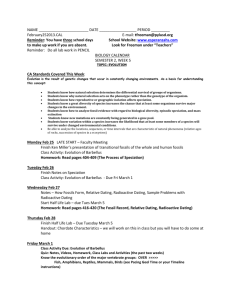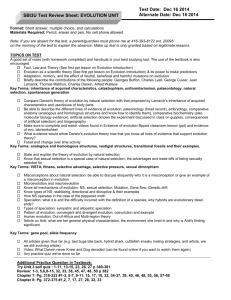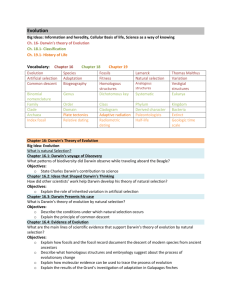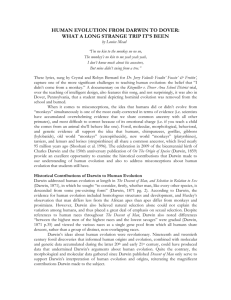College-Prep Biology Evolution Test Review Sheet_1_
advertisement
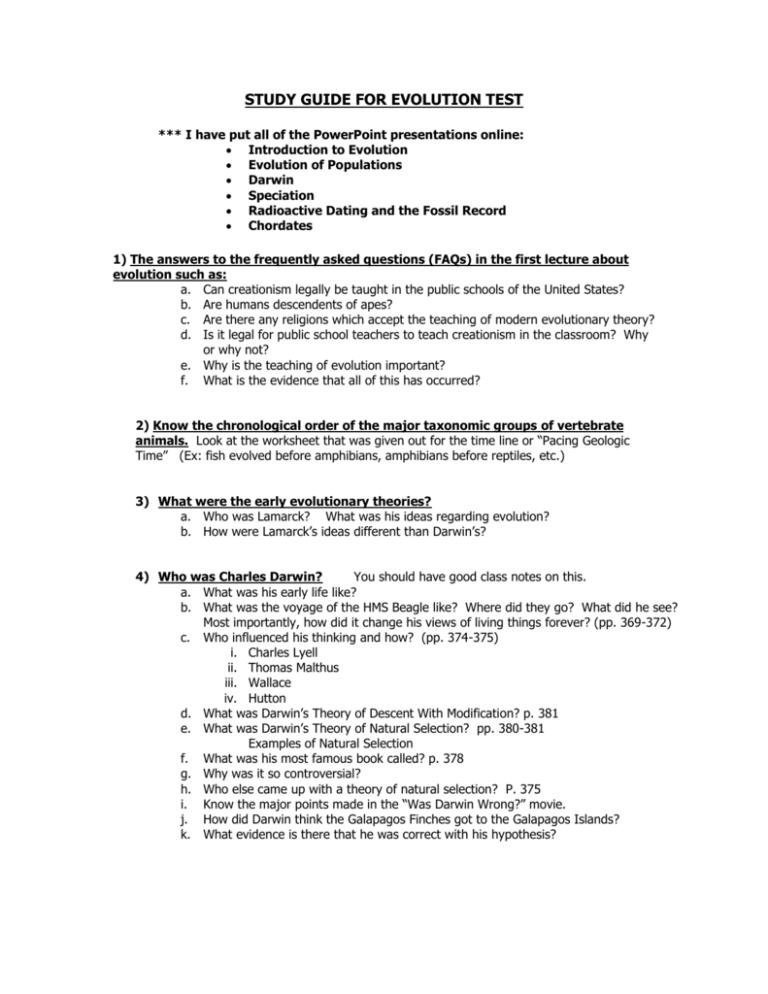
STUDY GUIDE FOR EVOLUTION TEST *** I have put all of the PowerPoint presentations online: Introduction to Evolution Evolution of Populations Darwin Speciation Radioactive Dating and the Fossil Record Chordates 1) The answers to the frequently asked questions (FAQs) in the first lecture about evolution such as: a. Can creationism legally be taught in the public schools of the United States? b. Are humans descendents of apes? c. Are there any religions which accept the teaching of modern evolutionary theory? d. Is it legal for public school teachers to teach creationism in the classroom? Why or why not? e. Why is the teaching of evolution important? f. What is the evidence that all of this has occurred? 2) Know the chronological order of the major taxonomic groups of vertebrate animals. Look at the worksheet that was given out for the time line or “Pacing Geologic Time” (Ex: fish evolved before amphibians, amphibians before reptiles, etc.) 3) What were the early evolutionary theories? a. Who was Lamarck? What was his ideas regarding evolution? b. How were Lamarck’s ideas different than Darwin’s? 4) Who was Charles Darwin? You should have good class notes on this. a. What was his early life like? b. What was the voyage of the HMS Beagle like? Where did they go? What did he see? Most importantly, how did it change his views of living things forever? (pp. 369-372) c. Who influenced his thinking and how? (pp. 374-375) i. Charles Lyell ii. Thomas Malthus iii. Wallace iv. Hutton d. What was Darwin’s Theory of Descent With Modification? p. 381 e. What was Darwin’s Theory of Natural Selection? pp. 380-381 Examples of Natural Selection f. What was his most famous book called? p. 378 g. Why was it so controversial? h. Who else came up with a theory of natural selection? P. 375 i. Know the major points made in the “Was Darwin Wrong?” movie. j. How did Darwin think the Galapagos Finches got to the Galapagos Islands? k. What evidence is there that he was correct with his hypothesis? 5) What is the evidence of evolution? Be able to explain or give examples of the following: see pp. 382-385 and your class notes a. Similar DNA sequences among organisms b. Vestigial structures c. Commonly shared proteins among organisms (Ex: hemoglobin, cytochrome c) d. The fossil record e. Similar anatomy among organisms f. Homologous Structures/Organs among vertebrates g. Transitional fossils (good lecture by Ken Miller that you saw in class) h. Similarities in Embryological Development i. Geographic distribution of living species 6) Half Life Lab: see pages 417-420 a. What is meant by the term, “half life? and radioactive/radiometric dating? b. What is the difference between Relative Dating and Radioactive Dating? c. What are the types of elements used to calculate absolute ages of fossils? d. How do scientists use the half-lives of radioactive elements to determine ages of fossils? e. Be able to do some problems associated with calculating half lives. – class notes 7) What is Speciation? pp. 404-407 a. What is a species? b. What are the requirements for speciation to occur? c. What are some examples of speciation that have occurred? 8) Cladogram Activity: a. What is a cladogram? b. What is meant by a phylogenetic tree? c. What type of information can be derived from a cladogram? d. Be able to make a cladogram using a group of selected vertebrates – know the major differences between the classes of vertebrates groups we covered in class (fish, amphibians, reptiles, mammals) see pages 1076-1077 (appendix of your book) 9) Primate Notes and Primate Classification Handout: a. Know the four characteristics of all chordates. b. Know the three groups of mammals – pp. 828-829 b. What are common characteristics of primates? pp. 833-835 c. Differentiate between Prosimians and Anthropoids. Give examples. (class notes) d. List the Lesser Apes and the order of their relatedness to humans. e. List the Great Apes and the order of their relatedness to humans. f. Be able to complete a phylogenetic tree of primates showing their relationship to humans – class handout

